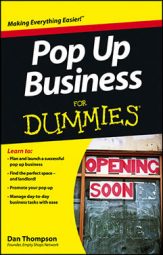Making sure that your pop up is open at the right time is for fairly obvious reasons very important, but this detail is often overlooked. If your opening times are right, you’ll be able to attract the highest number of visitors, in the shortest possible time. This means the highest profit at the lowest cost, of course.
Choosing set opening times and displaying them clearly in the window is vital. Don’t try to be clever; put a very clear list of opening days and times in the window, either hung up as a poster or by using printed vinyl stickers applied to the window. Nothing’s more disappointing for a pop up fan than turning up at an event to discover that it’s closed.
Put the same information on your website.
Only you can choose the opening times for your pop up, but here are some details to guide you:
Work out at what times your target audience can or cannot come to your pop up. For example, if you’re targeting young people, opening only during school hours limits the success of your pop up.
Look at local patterns of footfall. Your town centre manager may be able to provide footfall data, the statistical analysis of when customers use the town centre. If the town centre manager can’t help you, visit the location of your pop up at different times to gather some anecdotal evidence.
Identify peaks in footfall, such as on market days or during a local arts festival. Match your opening times to those increases, but be aware that they may not automatically bring you more visitors.
You’re better off advertising that you’re open for fewer hours and getting the highest number of visitors in the shortest time. Being open for more hours doesn’t mean you’ll get more visitors.
For the Artists and Makers Festival, artists opened their homes and studios to art lovers. In the early years, artists tried opening all week. It was hard work, and visitor numbers were slow but steady throughout the week.
In subsequent years, the festival chose to open only on weekends; the same number of visitors came, but all in a shorter time. The open houses felt busier and the staffing costs were reduced.
Some pop ups are open for one evening only, forcing all their visitors into a short space of time and making sure that their shop is bursting at the seams. This plan can work really well, but it’s a high-risk strategy. What happens if your short opening time coincides with a thunderstorm? Or even worse, somebody else throws an even better party just round the corner?
Local factors have an impact on footfall to a local area. Look for listings online, but also contact tourist information centres to ask for their inside knowledge.
Local events which may have an effect on your footfall include:
Arts, food and music festivals
Market days
Sports matches and events
Late-night shopping or seasonal shopping events
An increase in local footfall doesn’t necessarily mean a rise in visitors to your event. People who’ve come to a place for one event may not want (or have time) to visit another.

